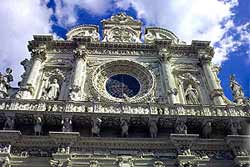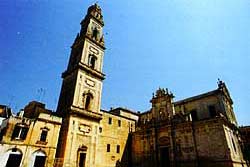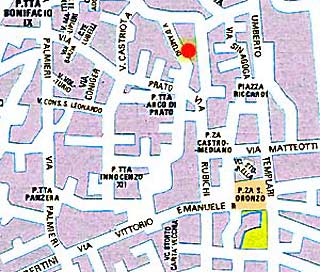One hundred thousands of inhabitants, twenty
six thousands of students, laid in Salento, land between seas
Ionio and Adriatico, characterized by a growth between tradition
and modernity, Lecce boasts a foundation
more ancient than Rome.
Place rich in monumental works of a wonderful barocco style "well-fed"
by the local leccese stone (which is famous all over the world),
the city was founded, according to the legend, by Malennio,
king of Salentini and founder of Lupiae and Rudiae,
and by Idomeneo,
king of Cretesi, forced - while coming back to Troia - to
land to the shores of Salento because of a tempest. Just from the
Idomeneo's origin land, Lycia,
the city of Lecce seems to take its name.
Although it has been due to the Romans the foundation of a real municipality
on the land of Lupiae,
it will suffer the preeminence of Rudiae, to which the Romans themselves
addressed more interest. In the course of the centuries of the Dark Ages,
the decline is so advanced that the tracks of local events were lost:
Lupiae was ignored to Otranto's advantage, place aided by
its particular geographical, and so strategic, position. The barbaric
invasions, with their devastations, made the rest.
The arrival of the Normanni
inverted this trend, so the city knew a general material and moral well-being,
becoming seat of County. Among the meaningful historical figures, we have
to remember Tancredi,
lover of arts and letters, count of Lecce and king of Sicily between 1169
and 1194, a period when the city reachs a real supremacy over the whole
region, before returning in a condition of decline with the Swabian dinasty.
With the Brienne, and above all thanks to Gualtieri
VI, there was a new period of
well-being.
When, in 1356, the County passes to the Enghien
dinasty, it begins a period of profitable trades with Venice, from which
cloths, glasses and artistic woodworks were imported in exchange for wheat,
oil and wine: it was the prelude of subsequential settlements of genoese,
florentine, greeks and albanians merchants. The economical growth, in
short, was really considerable.
Concluded the experience with the Enghien, the Naples' king Ferrante
d'Aragona collects the heritage
of wide possesions and wealths, sanctioning the end of the County: Lecce
became Crown's property and state city. Passed the political and military
events between 1400 e il 1500, the destiny of Terra d'Otranto was
leaded by the emperor Carlo V,
who considered Lecce as the most advanced rampart against the East and
so became promoter of a defensive system for the city and the coastline,
characterized by towers and fortified farms.
In the seventheenth century interventions of urbanistic increase, but
above all of architectural and esthetic exaltation, both laical and religious,
were made. The author was Luigi Pappacoda,
bishop from 1639 to 1670: by the glamour of the baroque art, he succeed
in relaunch the hegemony of Lecce above the whole Salento, also thanks
to the architect Giuseppe Zimbalo.
The main character of the second half of 1700 was another prelate, Alfonso
Sozi-Carafa, bishop from 1751
to 1783, who, in the footsteps of Pappacoda, strongly affected over the
ecclesiastic and building life of the city thanks to the work of his confidential
architect, Emanuele Manieri.
In 1806, while Giuseppe Bonaparte subdued the Due Sicilie's
kingdom, Lecce were enriched with a new residential building industry,
which beautified the new made avenues. The carrying out of the University
and of the new city, rose around the square dedicated to Giuseppe Mazzini,
is recent history (1956).
 S. Croce's church |
 Duomo' square |
You can find our workroom in the heart
of the old city, near S. Oronzo' square, in F. A. D'Amelio street, the
second crossroad to the right of Rubichi street, going down from Castromediano'
square to Porta Napoli.
 Click on the map to enlarge. |